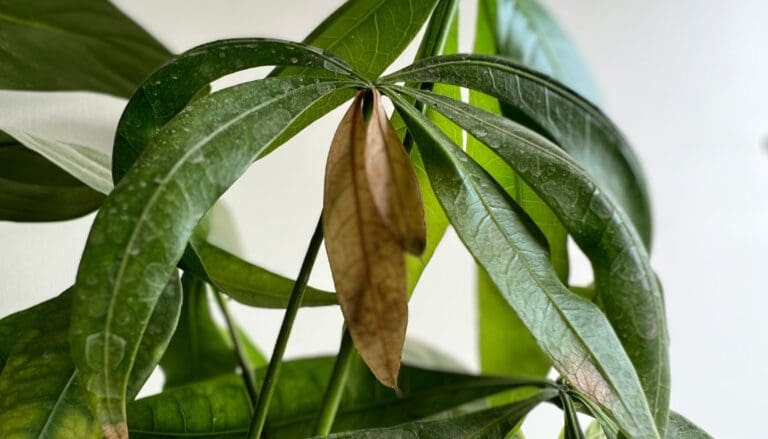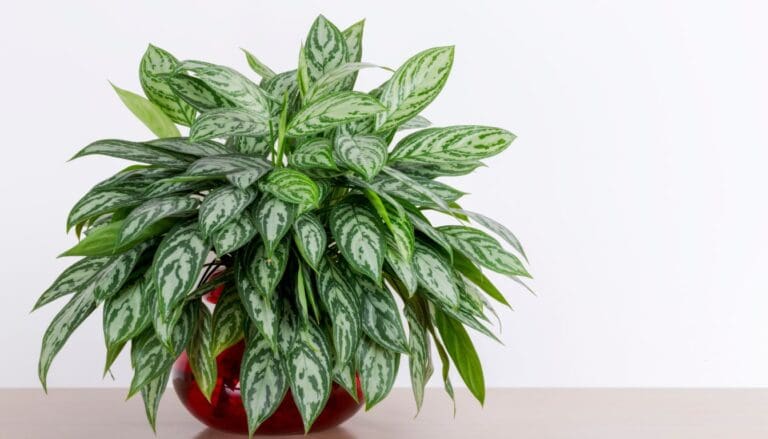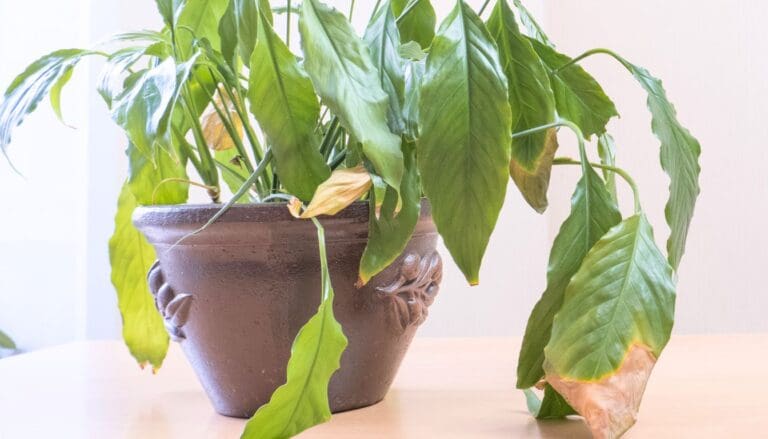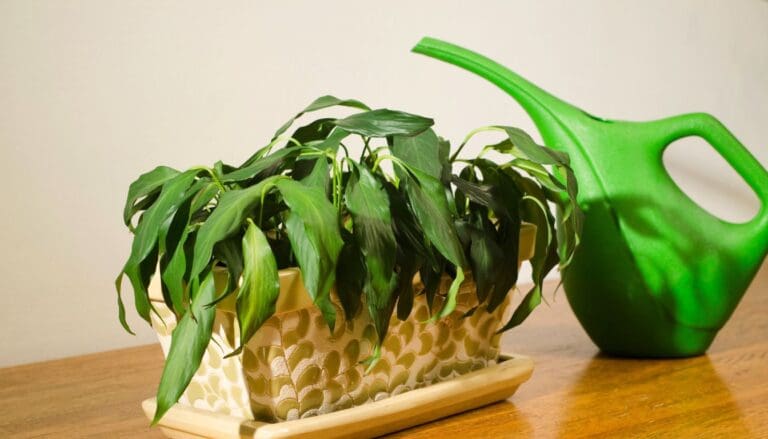Alocasia Falling Over or Leaning? Why & Easy Fix!
Have you ever noticed your Alocasia plant leaning to one side and wondered why? This blog will explore the possible problems behind this and share some ways to fix it.
Overwatering or underwatering are the most prevalent causes of a leaning Alocasia. Temperature stress, pest problems, and poor soil are other causes that can make your alocasia lean. Prune the plant occasionally and provide appropriate support to prevent leaning.
Leaning usually happens because of improper care. You should never ignore your plant’s needs and take proper care to prevent the plant from leaning.
Your alocasia can recover easily if the underlying condition is addressed on time. In this article, you will understand every possible cause behind leaning alocasia, along with ways to keep alocasia upright.

Please note: Simplify Plants is reader-supported. Some links in the post are affiliate links and I get a commission from purchases made through links in the post.
My alocasia is leaning: How do you keep alocasia upright?
Here is a list of every possible cause, and discuss them and their solutions in detail.
- Lighting issues
- Improper watering
- Temperature stress
- Inadequate fertilization
- Inappropriate soil
- Root-bound problem
- Pest infestations
- Lack of pruning
1) How Lighting Problems Can Cause Alocasia Leaning
Your alocasia can lean on one side if it doesn’t get proper light.
If your plant is in a dim area, it starts craving more light, which is why it leans towards the area where the light is brighter.
Not only can low light cause leaning, but providing the plant with bright, direct sunlight can also cause the same problem.
If the alocasia is exposed to intense sunlight, the plant’s transpiration rate increases and causes dehydration.
Due to this reason, the alocasia becomes weak, fails to stay rigid, and completely leans.
Also read: What Kind Of Light Does Alocasia Need? Alocasia Light Requirements
2) The Impact of Improper Watering on Alocasia falling over

Improper watering of your alocasia can cause various health issues, and leaning is one of them.
Sometimes, people fail to understand when to water the plant and how much.
Therefore, the plant can suffer from both underwatering and overwatering.
Watering alocasia can often lead to overwatering, which can cause serious health problems for the plant.
Due to overwatering, the roots fail to breathe and suffocate, leading to root rot disease.
Alocasia cannot obtain water and nutrients from the damaged roots, which causes weakness, and the plant starts leaning.
Underwatering occurs when you don’t water your alocasia for a longer period.
Lack of water causes weakness, and the plant starts leaning.
Fortunately, you can recover the plant from underwatering easily, unlike overwatering.
In the case of underwatering, you have to water the plant properly for some days, and the plant will bounce back to normal.
Also read: How To Water Alocasia Plant? (How Much, How Often & More)
3) Alocasia Falling Over and the Influence of Temperature Stress
Alocasia prefers warm temperatures between 60-80°F.
When these plants are exposed to unsuitable temperatures, they can face problems restricting their growth.
If the temperature drops below 40°F, it becomes hard for the plant to survive.
Both low temperatures and sudden changes in the temperatures can directly affect the health of alocasia and cause extreme stress.
The leaves start to fall off, and alocasia starts leaning because of weakness.
4) Understanding the Role of Fertilization in Alocasia Leaning

Fertilization helps to encourage growth as it provides the required nutrients to the plants.
But overdoing it can also cause severe damage to them.
If fertilizers are not used in the proper quantity and at the proper time, it can cause leaning in alocasia.
Your plant can get weak when they are not provided with sufficient nutrients.
Lack of nutrition can cause droopy leaves, and the plant can eventually lean.
On the other hand, providing frequent fertilizers to the alocasia with higher doses is also an immense mistake.
Overfertilization burns the entire roots of a plant and makes them extremely weak.
This results in a leaning Alocasia.
Also read: What Fertilizer To Use For Alocasia? (Ideal Fertilizer+Dosage Guide)
5) Alocasia Leaning Due to Inappropriate Soil Conditions
Soil plays a crucial role in the growth of a plant.
If the soil is unsuitable for alocasia, it can directly affect their growth and health.
If the soil drains too fast or slow, it can cause leaning in alocasia.
There are two types of soil that alocasia doesn’t prefer, i.e., clayey soil and sandy soil.
Clayey soil is too tight, resulting in slow drainage.
Because of this, the soil can be waterlogged frequently, which leads to overwatering.
Thus, the plant leans.
In the case of sandy soil, it drains too fast, which is why roots fail to absorb enough water and nutrients, resulting in leaning.
Also read: What Kind Of Soil Does Alocasia Need? (Ideal Soil Mix+Other Requirements)
6) Addressing Alocasia Falling Over Caused by Root-Bound Issues

It will get rootbound if you haven’t repotted your alocasia for too long.
When the roots don’t get space inside the pot to grow further, they grow in a circular motion.
When your alocasia becomes rootbound, its roots get tangled and lose the ability to absorb water and nutrients from the soil.
Due to a lack of water and nutrients, the plant starts to lean.
Also read: Do Alocasia Like To Be Root Bound? (+When To Repot)
7) Identifying Pest Infestations as a Cause of Alocasia Leaning Over
Pests that attack alocasia might even kill the plant.
The pests you will often see on alocasia are scales, aphids, mealybugs, spider mites, etc.
All these pests are known as sap-sucking insects.
Pests suck out the sap from the plant and leave it fragile.
Due to this, the plant becomes dehydrated with no nutrients and starts leaning to one side.
To determine whether your alocasia is attacked by pests, take a close look at it or use a magnifying glass.
You will see them on leaves, stems, or lateral buds.
Also read: How Do I Get Rid Of Bugs In Alocasia? (+Common Bugs Identification)
8) Lack of pruning Can Lead To A Leaning Alocasia Plant
Every plant requires pruning from time to time for new and even growth.
Not pruning your alocasia on time can make the plant bulky with unequal growth.
This happens because unwanted leaves take up all the needed nutrients for roots and stems.
Due to bulky leaves and weaker stems or roots, the plant bends on one side, resulting in leaning.
Lack of pruning not only discourages growth, but the already damaged and infected leaves can also infect other healthy parts of a plant, making them completely unhealthy.
So, pruning is necessary to keep alocasia strong, healthy, and disease-free.
Also read: Where To Prune Alocasia? (Best Time+How To)
How do you fix a leaning Alocasia?
After knowing all the possible reasons behind a leaning Alocasia, let us discuss how you can fix the same.
Fixing your leaning alocasia is easy as you need to provide basic requirements like watering, fertilizing, and lighting.
1) Provide alocasia with bright indirect light.

As we have already discussed how inadequate sunlight can affect the plant’s health, you should carefully consider this matter.
Both low light and excessive light can cause leaning.
Alocasia needs at least 6-8 hours of bright indirect light, so place the plant near a well-lit window.
While keeping the plant near a window, cover the window with a sheer curtain to protect the plant from direct sunlight.
If not, place the plant 5-10 feet from the window.
You can use artificial lights if your alocasia is not getting sufficient natural light.
2) Perform proper watering
Alocasia needs watering once a week, early in the morning.
Always check the soil before watering your alocasia; it should be at least 25-50% dry.
Use a moisture meter to check the soil’s moisture.
To rescue the plant from overwatering, stop watering your alocasia immediately and let the soil get dry.
Try to provide indirect sunlight to your alocasia for fast evaporation.
Frequent watering can easily cause overwatering, so stop doing that.
If the root rot problem has already occurred, repot your alocasia in a whole new pot with fresh soil.
On the other hand, recovering an underwatered plant is easier than saving an overwatered one.
If you notice that the soil is compact and dry, take a chopstick and poke some holes into the soil to aerate it.
Then, water the plant deeply until excess water emerges from the drainage holes.
Frequent misting can also help your plant stay hydrated, so you can do that daily, as there is no chance of overwatering and underwatering.
3) Maintain the correct temperature

Try to maintain a warm temperature between 65-85°F.
You can use a thermostat device to control the room temperature.
Try to provide your alocasia with a whole day of indirect sunlight.
This can provide warmth to your alocasia to some extent.
Don’t keep your alocasia near a window and door that opens and closes often.
This results in sudden changes in the temperature that can stress your alocasia.
Keep your alocasia away from heating objects like a heater, radiator, or fireplace.
Introducing the plant in extreme heat can cause trouble.
Not only heating objects but keeping alocasia near cooling objects like Air conditioners or refrigerators can also create the same issue.
So avoid doing that.
Avoid keeping alocasia near a window if the climate is extreme, like cold and hot drafts.
4) Change the soil or improve the soil structure.
If the soil is too tight or loose, you should change it with a fresh one or improve it.
The best soil mix for alocasia is a mixture of peat moss, perlite, and potting mix.
The ideal soil mixture for alocasia should be well-drained, aerated, and retain proper moisture.
If you don’t want to change the entire soil, you can also improve the existing soil by adding extra substance.
You can add sand, gypsum powder, or brick powder if the soil is heavy.
This will make the soil well-draining.
If the soil is loose and draining fast, add some clay, compost, or manure.
Other than this, you can also mulch around the soil surface to improve moisture retention.
5) Provide your Alocasia with the right amount of fertilizer

Fertilize your alocasia throughout the spring and summer, as it is a heavy feeder.
You should use a balanced liquid fertilizer in the NPK ratio of 20:20:20.
Make sure you don’t apply strong doses to the plant.
Mix the fertilizer in the water to make it half-strength, then apply it.
Don’t fertilize your alocasia during winter, as it is their dormant period.
To rescue the plant from overfertilization, you should change the soil by repotting the alocasia and not fertilizing it until it fully recovers.
6) Get rid of pests
Remove any pests that have attacked your alocasia as quickly as possible.
To remove the pests, mix water with isopropyl alcohol and spray the entire plant with it.
You can use a wet cloth or cotton ball and gently rub it in the infected area.
Spray a neem oil solution on your alocasia every month to prevent the plant from future infestations.
7) Repot your Alocasia
If your alocasia is rootbound, repot your plant to fix the problem.
Choose a 1-2 inches larger pot than the old one for repotting and use a fresh potting mix.
You should repot on time without stressing your plant.
Alocasia should be repotted every 18-24 months.
Make sure you do the repotting only during the growing season.
Also read: When Do You Repot Alocasia Plant? (Ideal Time+How To)
8) Prune your Alocasia regularly
It is very important to trim your alocasia occasionally for proper growth.
As soon as you notice any unequal growth or damaged parts, immediately cut them off.
Always use sharp and sterilized pruners to make a fresh and clean cut.
Make sure to cut carefully and remove only the excess leaves or damaged parts without harming the healthy ones.
How do I keep my alocasia upright?

If your alocasia is too long and it’s getting difficult for them to stand upright, two ways can help keep your plant upright.
These are:
- Prune the alocasia from the top
- Provide support to the plant by using stakes
Prune your plant from the top
Cut the top to lower the length if your alocasia is too long. This will help your plant stay upright easily.
After cutting the extended area, you should trim all excess leaves to encourage new growth. Make sure you cut from the lateral buds.
Cutting the unequal growth and excess leaves will promote proper growth, and the plant will stay upright easily.
Support your alocasia with a stake.
You can use stakes to keep the plant upright if you don’t want your alocasia to lean.
Choose a stake that is a bit longer than your plant, and then place 1-2 inches deep in the soil.
If one stake is not enough for your alocasia to stay upright, you can use more.
Care tips to keep your alocasia healthy
- Alocasia prefers bright indirect light, so avoid keeping them in dark areas or under direct sunlight.
- Don’t place the plant near heating objects or direct air from the AC.
- Reduce watering and stop fertilizing in winter.
- Spray a neem oil solution every month to prevent pests.
- Don’t keep your alocasia near a window that gets cold drafts and frost, which can shock your plant.
- Try to maintain proper temperature and humidity for your alocasia.
- Repot your alocasia every 1.5-2 years to keep it healthy.

Reference: Alocasia sanderiana, Alocasia micholitziana.
Recommended Garden Supplies
| Product Image | Our Recommended Gardening Supplies | Check Offers! |
|---|---|---|
Top Top
Top
Top
Top
Top
Top
Top
Top | rePotme Houseplant and Tropical Classic Potting Soil Mix | Check Offer On Amazon |
 Top
Top
Top
Top
Top
Top
Top
Top | Espoma Organic Indoor Plant Food | Check Offer On Amazon |
 Top
Top
Top
Top
Top
Top
Top
Top | GooingTop LED Grow Light 6000K Full Spectrum Clip Plant Growing Lamp | Check Offer On Amazon |
 Top
Top
Top
Top
Top
Top
Top
Top | Soil Moisture Meter | Check Offer On Amazon |
 Top
Top
Top
Top
Top
Top
Top
Top | Govee Hygrometer Thermometer, Bluetooth Enabled! | Check Offer On Amazon |
 Top
Top | LEVOIT Humidifiers for Large Room(Best For Plants) | Check Offer On Amazon |
 Top
Top
Top
Top
Top
Top
Top
Top | Upgraded DIY Automatic Drip Irrigation Kit, 15 Potted Houseplants Support | Check Offer On Amazon |
 Top
Top
Top
Top
Top
Top
Top
Top | Stainless Steel Heavy Duty Gardening Tool Set | Check Offer On Amazon |
 Top
Top
Top
Top
Top
Top
Top
Top | Bonide Insecticidal Soap | Check Offer On Amazon |
 Top
Top
Top
Top
Top
Top
Top
Top | Bonide 32 oz Spray Neem Oil for Organic Gardening | Check Offer On Amazon |
 Top
Top
Top
Top
Top
Top
Top
Top | Garden Safe Fungicide | Check Offer On Amazon |






